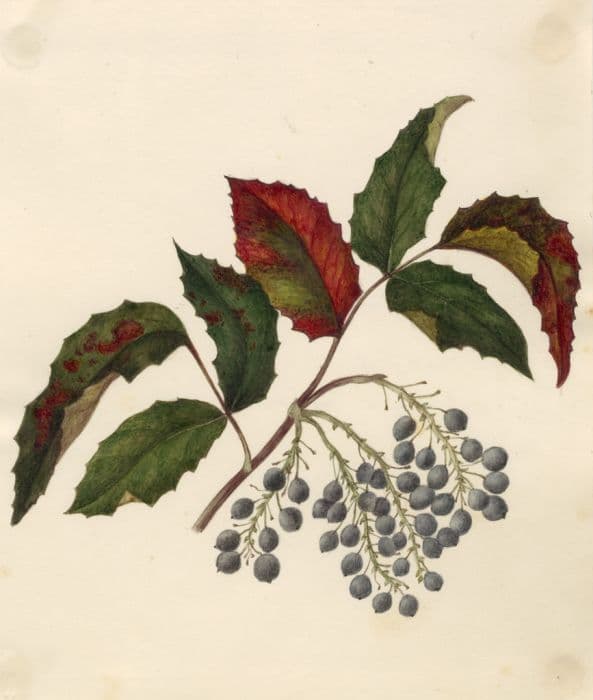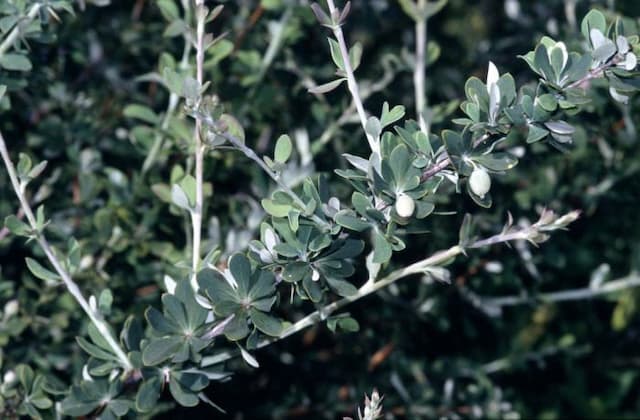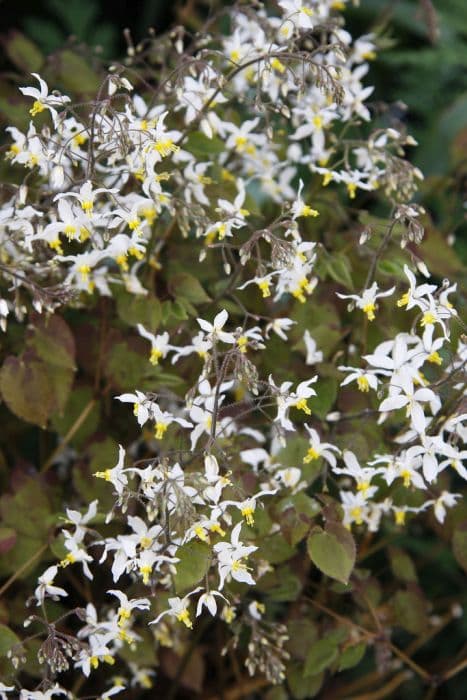Japanese Barberry Berberis thunbergii

ABOUT
Berberis thunbergii, commonly known as Japanese barberry, is a deciduous shrub characterized by a dense, rounded form. Its branches are often spiny, with small, sharp thorns that can be quite prickly to the touch. This plant is notable for its vibrant foliage that comes in a variety of colors depending on the specific cultivar. The leaves of Japanese barberry are small, spoon-shaped to oval, and can be seen in shades of green, reddish-purple, or even a bright lime color. In the fall, the foliage typically transforms to eye-catching shades of orange, yellow, or red, providing spectacular autumn color. During spring, Japanese barberry produces small, pendulous yellow flowers that hang in clusters. These blooms are inconspicuous and not particularly showy, but they do add subtle interest to the spring landscape. Following the flowering period, the plant produces small, bright red berries that persist well into the winter and provide a food source for local bird populations. These berries also contribute to the ornamental appeal of the plant in the colder months. The texture of Japanese barberry adds a fine to medium dimension to the landscape due to its tight foliage and branching structure. When used for landscaping purposes, this plant is popular for its varied seasonal interest, from flowers in the spring to berries in the winter and the numerous color changes of its leaves throughout the seasons.
About this plant
 Names
NamesFamily
Berberidaceae
Synonyms
Japanese Barberry, Thunberg's Barberry, Red Barberry
Common names
Berberis thunbergii var. maximowiczii, Berberis maximowiczii.
 Toxicity
ToxicityTo humans
Japanese barberry (Berberis thunbergii) contains alkaloids that can be harmful if ingested in significant quantities. It is not commonly regarded as a highly toxic plant to humans, but consuming the berries or other parts of the plant can potentially cause vomiting, diarrhea, or lethargy. As with any plant, individual sensitivity may vary, so it's best to avoid ingestion and seek medical attention if symptoms occur after consuming any part of the Japanese barberry.
To pets
Japanese barberry is also considered to possess a level of toxicity to pets. The berries and other parts of the plant contain alkaloids that can be harmful to dogs and cats if eaten. While it is not typically known as a severely toxic plant, ingestion can cause symptoms such as vomiting, diarrhea, and lethargy in pets. If your pet consumes Japanese barberry, it is advisable to contact a veterinarian, especially if any symptoms develop.
 Characteristics
CharacteristicsLife cycle
Perennials
Foliage type
Deciduous
Color of leaves
Varies
Flower color
Yellow
Height
2-8 feet (0.6-2.4 meters)
Spread
4-7 feet (1.2-2.1 meters)
Plant type
Shrub
Hardiness zones
4-8
Native area
Japan
Benefits
 General Benefits
General Benefits- Ornamental Value: Berberis thunbergii, commonly known as Japanese barberry, boasts vibrant foliage that changes color throughout the seasons, making it a popular choice for ornamental use in landscapes and gardens.
- Habitat for Wildlife: The dense thicket of the plant provides excellent cover and nesting opportunities for birds and small mammals.
- Erosion Control: Its extensive root system helps stabilize soil and can prevent erosion, particularly on slopes or in areas prone to soil degradation.
- Drought Resistance: Japanese barberry is known for its ability to withstand periods of drought, making it suitable for xeriscaping and water-efficient landscapes.
- Low Maintenance: Once established, this plant requires minimal care, making it a good choice for gardeners seeking low-maintenance landscaping options.
- Cold Hardy: The plant is highly cold-resistant, capable of surviving and thriving in a wide range of temperate climates.
- Privacy Screen: With its dense growth habit, Japanese barberry can be used as a natural screen or hedge, providing privacy and blocking undesirable views.
 Medical Properties
Medical Properties- This plant is not used for medical purposes.
 Air-purifying Qualities
Air-purifying QualitiesThis plant is not specifically known for air purifying qualities.
 Other Uses
Other Uses- Japanese barberry can be used to create natural barriers or hedge rows due to its dense growth and thorns, which can deter trespassers and animals.
- The thorny branches may be collected and used to construct natural fences for livestock or garden plots in rural areas.
- With its colorful foliage and berries, Japanese barberry is often planted for ornamental purposes in gardens and parks.
- Its dense root system makes it useful for erosion control on slopes or in areas where soil retention is necessary.
- Crafting enthusiasts sometimes use the dried branches of Japanese barberry for making wreaths and other decorative items.
- Japanese barberry can be planted as part of a wildlife garden, providing shelter and food for birds and other small animals.
- In regions where it's considered invasive, the plant is used for educational purposes to teach about the impact of non-native species.
- Photographers and painters often use Japanese barberry as a subject due to its vibrant colors and interesting textures.
- Eco-conscious individuals may use uprooted Japanese barberry in compost as brown material, if local regulations allow.
- During winter, the brightly colored berries provide a stark contrast to snowy landscapes, making it a popular choice for winter gardens.
Interesting Facts
 Feng Shui
Feng ShuiThe Japanese Barberry is not used in Feng Shui practice.
 Zodiac Sign Compitability
Zodiac Sign CompitabilityThe Japanese Barberry is not used in astrology practice.
 Plant Symbolism
Plant Symbolism- Protection: Berberis thunbergii, commonly known as Japanese barberry, often has sharp thorns, which can symbolize protection and defense. It serves as a botanical barrier in gardens and can be interpreted as a symbol for safeguarding one's space.
- Resilience: This plant is known for its hardiness and ability to tolerate a variety of soil and climate conditions, making it symbolic of resilience and adaptability in the face of adversity.
- Beauty within Boundaries: With its attractive foliage and berries, Japanese barberry can symbolize the concept of finding and appreciating beauty within certain limits or boundaries, echoing its use as a hedge or border plant.
 Water
WaterJapanese Barberry requires consistent moisture, but it is important not to overwater. The soil should be kept moderately moist. During the growing season, water the plant deeply once a week, providing about 1-2 gallons per watering session, depending on the size and maturity of the plant. In hot, dry periods, you may need to water twice a week, while in cooler, wetter conditions, watering can be reduced. Ensure that the soil drains well to prevent root rot. For established plants, they are drought tolerant and can withstand periods without water, but for optimal growth, maintain regular watering.
 Light
LightJapanese Barberry thrives in full sun to partial shade. The ideal spot would allow the plant to receive at least 6 hours of direct sunlight each day. They can tolerate shade, but flowering and fall color are more pronounced with greater light exposure. Avoid deep shade locations, as this can lead to a decrease in the plant's vibrant foliage and overall vigor.
 Temperature
TemperatureJapanese Barberry is hardy and adapts well to a range of temperature conditions. It can withstand winter temperatures as low as -30°F, making it suitable for many climates. The plant prefers temperatures between 60°F and 70°F during the growing season but is extremely versatile. Avoid planting in locations where temperatures consistently exceed 95°F, as extreme heat can stress the plant.
 Pruning
PruningPruning Japanese Barberry is necessary to maintain its shape, remove dead or diseased branches, and encourage new growth. The best time for pruning is late winter or early spring before new growth begins. It can be pruned annually to shape the plant or every few years for size control. Always use clean, sharp tools to make precise cuts and avoid tearing the branches.
 Cleaning
CleaningAs needed
 Soil
SoilJapanese Barberry thrives in well-draining soil rich in organic matter, ideally with a pH between 6.0 and 7.5; a mix of garden soil, compost, and peat moss is recommended.
 Repotting
RepottingJapanese Barberry is typically repotted every 2 to 3 years as it is a slow-growing shrub; however, mature plants may rarely need repotting.
 Humidity & Misting
Humidity & MistingJapanese Barberry is tolerant of a range of humidity levels and does not require specific humidity conditions for optimal growth.
 Suitable locations
Suitable locationsIndoor
Provide bright light, occasional watering, and prune to manage size for Japanese Barberry.
Outdoor
Plant in full sun to partial shade, ensure soil drainage for Japanese Barberry.
Hardiness zone
4-8 USDA
 Life cycle
Life cycleBerberis thunbergii, commonly known as Japanese barberry, starts its life cycle as a seed, which can stay dormant in the soil until conditions are favorable for germination. Upon sprouting, the seedling emerges and establishes itself, gradually growing into a shrub with a distinct thorny stem and developing its characteristic small, oval green leaves. In spring, the plant produces yellow flowers that are attractive to pollinators, which then give way to bright red, oblong berries by late summer or fall, providing food for birds and wildlife. These fruits disperse seeds, either through animal consumption or by dropping to the ground, perpetuating the cycle. During its vegetative state, which can last many years, Japanese barberry can also spread vegetatively through the root system, creating dense thickets. The plant is deciduous, losing its leaves in the fall but retaining its thorny, reddish-brown stems throughout winter until the next growing season begins.
 Propogation
PropogationPropogation time
Late fall to early winter
The Japanese barberry (Berberis thunbergii) is commonly propagated by seed or by softwood cuttings. However, the most popular method is using softwood cuttings, which is typically done in late spring or early summer when new growth is still tender and flexible. To propagate by this method, a gardener would cut a piece of the stem that includes at least two or three sets of leaves, ideally 4 to 6 inches long. The cut end is then dipped in rooting hormone to encourage root development and placed in a well-draining soil mix. The cuttings should be kept in a humid environment with indirect light until roots have formed, which can take several weeks. Once rooted, the new plants can be gradually acclimatized to outdoor conditions and then planted in their permanent locations.









